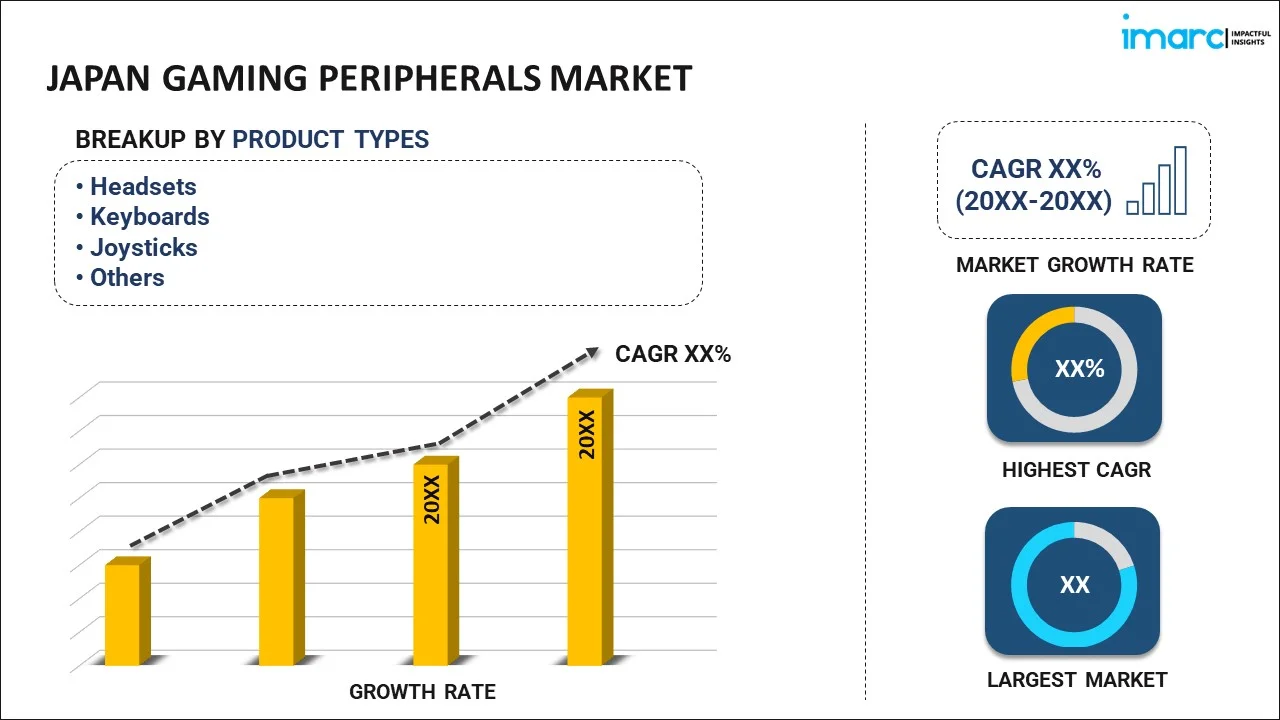
Japan Gaming Peripherals Market Report by Product Type (Headsets, Keyboards, Joysticks, Mice, Gamepads, and Others), Gaming Device Type (PC (Desktop/Laptop), Gaming Consoles), Technology (Wired, Wireless), Distribution Channel (Online, Offline), and Region 2025-2033
Market Overview:
The Japan gaming peripherals market size reached USD 259 Million in 2024. Looking forward, IMARC Group expects the market to reach USD 473 Million by 2033, exhibiting a growth rate (CAGR) of 6.9% during 2025-2033.
|
Report Attribute
|
Key Statistics
|
|---|---|
|
Base Year
|
2024
|
|
Forecast Years
|
2025-2033
|
|
Historical Years
|
2019-2024
|
|
Market Size in 2024
|
USD 259 Million |
|
Market Forecast in 2033
|
USD 473 Million |
| Market Growth Rate 2025-2033 | 6.9% |
Gaming peripherals are auxiliary devices used to control the actions of games on personal computers (PCs) or laptops. These peripherals include headsets, mechanical keyboards, mice and joysticks, which enhance the overall gaming experience of users. The growing traction of virtual reality (VR) games and the escalating demand for handheld consoles are offering lucrative opportunities to manufacturers in Japan.
Advancements in the gaming industry, in confluence with the increasing number of professional gamers, represents one of the key factors spurring the market growth in Japan. Moreover, the easy availability of consoles with built-in Universal Serial Bus (USB) ports is impelling the market growth. Apart from this, the introduction of PCs that support innovative features, such as high-quality graphics, facial recognition and gesture-based gaming, is positively influencing the sales of gaming peripherals in the country. Furthermore, due to the mass spread of the coronavirus disease (COVID-19), governing agencies are promoting the adoption of social distancing measures, which, in turn, is escalating demand for gaming peripherals among individuals. However, the closure of various manufacturing facilities has delayed the production of gaming peripherals in the country.
Key Market Segmentation:
IMARC Group provides an analysis of the key trends in each segment of the Japan gaming peripherals market report, along with forecasts at the country and regional levels from 2025-2033. Our report has categorized the market based on product type, gaming device type, technology and distribution channel.
Breakup by Product Type:

- Headsets
- Keyboards
- Joysticks
- Mice
- Gamepads
- Others
Breakup by Gaming Device Type:
- PC (Desktop/Laptop)
- Gaming Consoles
Breakup by Technology:
- Wired
- Wireless
Breakup by Distribution Channel:
- Online
- Offline
Breakup by Region:
.webp)
- Kanto Region
- Kinki Region
- Central/ Chubu Region
- Kyushu-Okinawa Region
- Tohoku Region
- Chugoku Region
- Hokkaido Region
- Shikoku Region
Competitive Landscape:
The competitive landscape of the industry has also been examined along with the profiles of the key players.
Report Coverage:
| Report Features | Details |
|---|---|
| Base Year of the Analysis | 2024 |
| Historical Period | 2019-2024 |
| Forecast Period | 2025-2033 |
| Units | Million USD |
| Segment Coverage | Product Type, Gaming Device Type, Technology, Distribution Channel, Region |
| Region Covered | Kanto Region, Kinki Region, Central/Chubu Region, Kyushu-Okinawa Region, Tohoku Region, Chugoku Region, Hokkaido Region, Shikoku Region |
| Customization Scope | 10% Free Customization |
| Post-Sale Analyst Support | 10-12 Weeks |
| Delivery Format | PDF and Excel through Email (We can also provide the editable version of the report in PPT/Word format on special request) |
Key Questions Answered in This Report:
- How has the Japan gaming peripherals market performed so far and how will it perform in the coming years?
- What has been the impact of COVID-19 on the Japan gaming peripherals market?
- What are the key regional markets?
- What is the breakup of the market based on the product type?
- What is the breakup of the market based on the gaming device type?
- What is the breakup of the market based on the technology?
- What is the breakup of the market based on the distribution channel?
- What are the various stages in the value chain of the industry?
- What are the key driving factors and challenges in the industry?
- What is the structure of the Japan gaming peripherals market and who are the key players?
- What is the degree of competition in the industry?
Need more help?
- Speak to our experienced analysts for insights on the current market scenarios.
- Include additional segments and countries to customize the report as per your requirement.
- Gain an unparalleled competitive advantage in your domain by understanding how to utilize the report and positively impacting your operations and revenue.
- For further assistance, please connect with our analysts.
 Request Customization
Request Customization
 Speak to an Analyst
Speak to an Analyst
 Request Brochure
Request Brochure
 Inquire Before Buying
Inquire Before Buying




.webp)




.webp)












